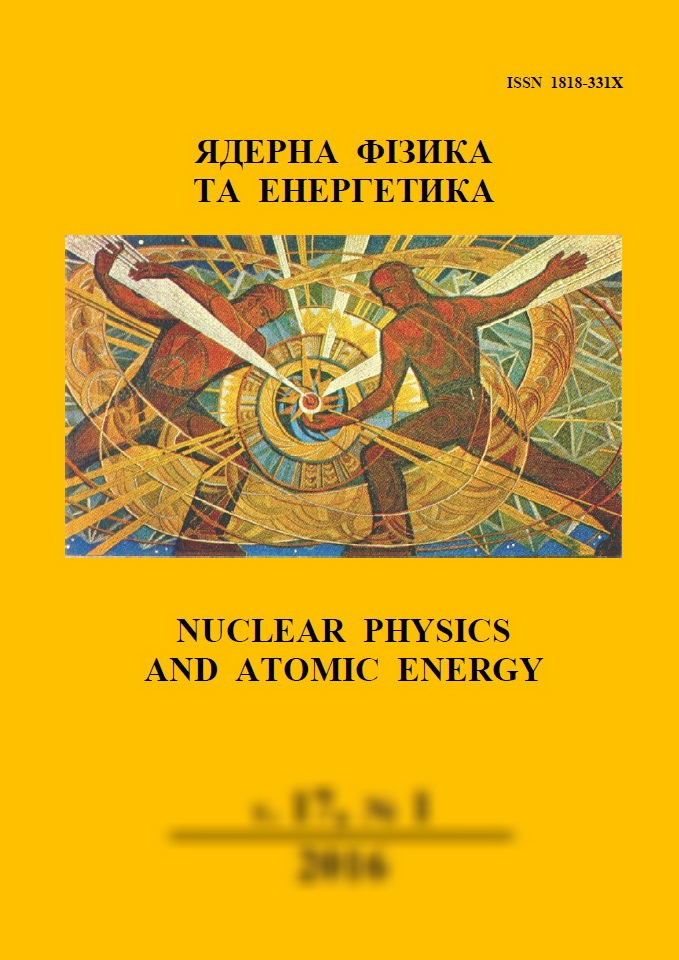 |
Ядерна фізика та енергетика
Nuclear Physics and Atomic Energy
ISSN:
1818-331X (Print), 2074-0565 (Online)
Publisher:
Institute for Nuclear Research of the National Academy of Sciences of Ukraine
Languages:
Ukrainian, English, Russian
Periodicity:
4 times per year
Open access peer reviewed journal
|
Nucl. Phys. At. Energy 2016, volume 17, issue 4, pages 337-348.
Section: Nuclear Physics.
Received: 03.08.2016; Accepted: 14.02.2017; Published online: 10.04.2017.
 Full text (en)
Full text (en)
https://doi.org/10.15407/jnpae2016.04.337
To the nature of 0+ excitations in deformed nuclei of actinides
A. I. Levon1,*, P. Alexa2, S. Pascu3, P. G. Thirolf4
1 Institute for Nuclear Research, National Academy of Sciences of Ukraine, Kyiv, Ukraine
2 Institute of Physics and Institute of Clean Technologies, Technical University of Ostrava, Czech Republic
3 H. Hulubei National Institute of Physics and Nuclear Engineering, Bucharest, Romania
4 Fakultat fur Physik, Ludwig-Maximilians-Universitat Munchen, Garching, Germany
*Corresponding author. E-mail address:
levon@kinr.kiev.ua
Abstract:
The excitation spectra in the deformed nucleus 232U have been studied by means of the (p, t) reaction. 0+ assignments for 13 excited states and up to spin 6+ for other states are made from the angular distributions of tritons and the coupled-channel approximation analysis. Sequences of states are selected which can be treated as rotational bands. Moments of inertia have been derived from these sequences, whose values may be considered as evidence of the two- or one-phonon nature of these 0+ excitations. Experimental data are compared with interacting boson model (IBM) and quasiparticle-phonon model (QPM) calculations.
Keywords:
0+ states, collective bands, moments of inertia, nuclear models.
References:
1. S.R. Lesher, A. Aprahamian, L. Trache et al. New 0+ states in 158Gd. Phys. Rev. C 66 (2002) 051305.
2. D.A. Meyer, V. Wood, R.F. Casten et al. Extensive investigation of 0+ states in rare earth region nuclei. Phys. Rev. C 74 (2006) 044309.
3. L. Bettermann, S. Heinze, J. Jolie et al. High-resolution study of 0+ states in 170Yb. Phys. Rev. C 80 (2009) 044333.
4. G. Ilie, R.F. Casten, P. von Brentano et al. Investigation of 0+ states in 192Pt and 194Pt isotopes. Phys. Rev. C 82 (2010) 024303.
5. C. Bernards, R.F. Casten, V. Werner et al. Investigation of 0+ states in 198Hg after two-neutron pickup. Phys. Rev. C 87 (2013) 024318.
6. D. Bucurescu, G. Graw, R. Hertenberger et al. High-resolution study of 0+ and 2+ excitations in 168Er with the (p, t) reaction.
Phys. Rev. C 73 (2006) 064309.
7. A.I. Levon, G. Graw, Y. Eisermann et al. Spectroscopy of 230Th in the (p, t) reaction. Phys. Rev. C 79 (2009) 014318.
8. A.I. Levon, G. Graw, R. Hertenberger et al. 0+ states and collective bands in 228Th studied by the (p, t) reaction. Phys. Rev. C 88 (2013) 014310.
9. N. Lo Iudice, A.V. Sushkov, N.Yu. Shirikova et al. Microscopic structure of low-lying 0+ states in the deformed 158Gd. Phys. Rev. C 70 (2004) 064316.
10. N. Lo Iudice, A.V. Sushkov, N.Yu. Shirikova et al. Microscopic structure of low-lying 0+ states in deformed nuclei. Phys. Rev. C 72 (2005) 034303.
11. N.V. Zamfir, Zhang Jing-ye, R.F. Casten et al. Interpreting recent measurements of 0+ states in 158Gd. Phys. Rev. C 66 (2002) 057303.
12. Y. Sun, A. Aprahamian, Zhang Jing-ye, Lee Ching-Tsai. Nature of excited 0+ states in 158Gd described by the projected shell model. Phys. Rev. C 68 (2003) 061301.
13. A.I. Levon, G. Graw, R. Hertenberger et al. Spectroscopy of 232U in the (p, t) reaction: Experimental data. Yaderna Fizyka ta Energetyka (Nucl. Phys. At. Energy) 17(3) (2016) 215.
14. E. Browne. Nuclear Data Sheets for A = 232. Nucl. Data Sheets 107 (2006) 2579.
15. R. Weiss-Reuter, H. Munzel, G. Pfennig. Decay of 232Np. Phys. Rev. C 6 (1972) 1425.
16. G. Ardisson, M. Hussonnois, J.F. LeDu et al. Levels of 23293U Fed in 236Pu α Decay. Phys. Rev. C 49 (1994) 2963.
17. M. Spieker, D. Bucurescu, J. Endres et al. Possible experimental signature of octupole correlations in the 0+2 states of the actinides. Phys. Rev. C 88 (2013) 041303.
18. F. Iachello, A. Arima. The Interacting Boson Model (England, Cambridge: Cambridge University Press, 1987).
19. J. Engel, F. Iachello. Interacting Boson Model of Collective Octupole States (I). The Rotational Limit. Nucl. Phys. A 472 (1987) 61.
20. N.V. Zamfir, D. Kusnezov. Octupole Correlations in the Transitional Actinides and the spdf Interacting Boson Model. Phys. Rev. C 63 (2001) 054306.
21. N.V. Zamfir, D. Kusnezov. Octupole correlations in U and Pu nuclei. Phys. Rev. C 67 (2003) 014305.
22. L.M. Robledo, R.R. Rodriguez-Guzman. Octupole deformation properties of actinide isotopes within a mean-field approach. J. Phys. G 39 (2012) 105103.
23. L.M. Robledo, P.A. Butler. Quadrupole-octupole coupling in the light actinides. Phys. Rev. C 88 (2013) 051302.
24. W. Nazarewicz, P. Olanders, I. Ragnarsson et al. Analysis of Octupole Instability in Medium-Mass and Heavy Nuclei. Nucl. Phys. A 429 (1984) 269.
25. P.A. Butler, W. Nazarewicz. Intrinsic Reflection Asymmetry in Atomic Nuclei. Rev. Mod. Phys. 68 (1996) 349.
26. R.F. Casten, D.D. Warner. The interacting boson approximation. Rev. Mod. Phys. 60 (1988) 389.
27. D. Kusnezov. The U(16) algebraic lattice. II. Analytic construction. J. Phys. A 23 (1990) 5673.
28. D. Kusnezov. The U(16) algebraic lattice. J. Phys. A 22 (1989) 4271.
29. D. Kusnezov. Computer code OCTUPOLE (unpublished).
30. V.G. Soloviev. Theory of Atomic Nuclei: Quasiparticles and Phonons (Bristol: Institute of Physics, 1992).
31. V.G. Soloviev Theory of Complex Nuclei (Oxford: Pergamon Press, 1976).
32. P. Moller, J.R. Nix, W.D. Myers, W.J. Swiatecki. Nuclear Ground-State Masses and Deformations. Atomic Data Nucl. Data Tables 59 (1995) 185.
33. P. Moller, J.R. Nix, K.-L. Kratz. Nuclear Properties for Astrophysical and Radioactive-Ion-Beam Applications. Atomic Data Nucl. Data Tables 66 (1997) 131.
34. T. Weber, J. de Boer, K. Freitag et al. Nuclear Levels in 228Th Populated in the Decay of 228Pa (II). Eur. Phys. J. A 3 (1998) 25.
35. A.V. Sushkov (Private communication).
36. N.I. Pyatov. Excitation of 0+ states in two-particle transfer reactions. Ark. Fys. 36 (1967) 667.
